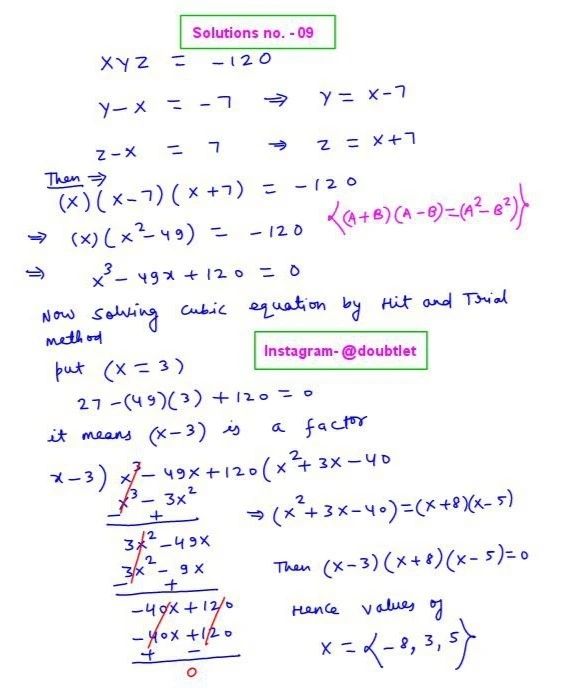









Matrix Row and Column Space: A Comprehensive Guide to Linear Algebra Concepts
Discover the key concepts of matrix row and column space in linear algebra. Learn how to calculate, interpret, and apply row and column spaces with practical examples, enhancing your understanding of matrix theory and linear systems.Matrix Row and Column Space are subspaces formed by the linear combinations of a matrix's rows and columns, respectively. The row space shows the span of the row vectors, while the column space represents the span of the column vectors. Both are crucial in understanding the matrix's rank, solving linear systems, and performing matrix operations in linear algebra.

Neetesh Kumar | September 26, 2024
Share this Page on:
![]()
![]()
![]()
![]()
![]()
- 1. Introduction to the Matrix Row and Column Space
- 2. What is Matrix Row and Column Space
- 3. How to Find the Matrix Row and Column Space
- 4. Rules for Matrix Row and Column Space
- 5. Properties of Matrix Row and Column Space
- 6. Matrix Row and Column Space Solved Examples
- 7. Practice Questions on Matrix Row and Column Space
- 8. FAQs on Matrix Row and Column Space
- 9. Real-Life Applications of Matrix Row and Column Space
- 10. Conclusion
1. Introduction to the Matrix Row and Column Space:
The row space and column space of a matrix are fundamental concepts in linear algebra that reveal important information about the structure of the matrix. Understanding these spaces helps solve systems of linear equations, perform matrix factorizations, and determine a matrix's rank. Row and column spaces are particularly important when working with linear transformations and understanding the span of vectors.
2. What is Matrix Row and Column Space:
The row space of a matrix is the subspace formed by the linear combinations of its row vectors. Similarly, the column space is the subspace formed by the linear combinations of its column vectors.
-
Row Space: The set of all possible linear combinations of the rows of the matrix. It shows the span of the row vectors.
-
Column Space: The set of all possible linear combinations of the columns of the matrix. It reflects the span of the column vectors.
Both spaces are subspaces of the vector space , and they help us understand the behavior and characteristics of the matrix in linear algebra.
3. How to Find the Matrix Row and Column Space:
Step-by-Step Process:
-
Row Space:
-
Write the matrix in its row echelon form (REF) or reduced row echelon form (RREF).
-
The non-zero rows in the RREF form are the basis vectors for the row space.
-
-
Column Space:
-
Identify the original matrix columns corresponding to the pivot columns (leading 1's) in the RREF form.
-
These columns form the basis for the column space.
-
Example:
Given a matrix:
-
To find the row space, reduce the matrix to RREF and identify the non-zero rows.
-
To find the column space, check which columns in the original matrix correspond to the leading columns in the RREF matrix.
4. Rules for Matrix Row and Column Space:
There are a few important rules to keep in mind when working with row and column spaces:
-
The row space and column space have the same dimension, known as the rank of the matrix.
-
The rank of the matrix is the number of linearly independent rows or columns.
-
A matrix is full rank if its rank equals the number of rows (for row space) or columns (for column space).
-
The null space and the column space of a matrix are orthogonal complements in the context of the matrix's total vector space.
These rules are fundamental in matrix theory and greatly help in understanding the structure of matrices.
5. Properties of Matrix Row and Column Space:
-
Row Space:
-
Consists of all linear combinations of the rows.
-
The dimension of the row space is equal to the rank of the matrix.
-
-
Column Space:
-
Consists of all linear combinations of the columns.
-
The dimension of the column space is also equal to the rank of the matrix.
-
-
Rank:
-
The rank is the dimension of the row or column space (always equal).
-
The rank reveals how many independent directions exist in the matrix.
-
-
Orthogonality:
-
The row space is orthogonal to the null space of the matrix.
-
The column space is orthogonal to the left null space.
-
These properties are essential when performing matrix decomposition, solving linear systems, or understanding linear transformations.
6. Matrix Row and Column Space Solved Examples:
Question: 1.
Find the Row and Column Space of a Matrix
Given the matrix:
Solution:
Step 1: Find the Row Space
First, reduce the matrix to RREF:
Using row reduction:
The only non-zero row is:
Thus, the basis for the row space is: Row Space of
Step 2: Find the Column Space
The pivot column in the RREF is the first column. We take the corresponding column from the original matrix , which is:
Thus, the basis for the column space is: Column Space of
Question: 2.
Find the Row and Column Space of a Matrix
Given the matrix:
Solution:
Step 1: Find the Row Space
Start by reducing the matrix to RREF:
The non-zero row in the RREF is:
Thus, the basis for the row space is: Row Space of
Step 2: Find the Column Space
The pivot column in the RREF is the first column. Therefore, we take the first column from the original matrix , which is:
Thus, the basis for the column space is: Column Space of
Question: 3.
Find the Row and Column Space of a Matrix
Given the matrix:
Solution:
Step 1: Find the Row Space
Reduce the matrix to its RREF:
The non-zero rows are:
,
These rows form the basis for the row space. Thus, the row space is:
Step 2: Find the Column Space
The pivot columns in the RREF are the first and second columns. Taking the corresponding columns from the original matrix , we get: ,
Thus, the basis for the column space is:
7. Practice Questions on Matrix Row and Column Space:
Q.1: Find the row space and column space of the matrix:
Q.2: Is the following matrix full rank? If so, find its row and column spaces:
Q.3: Given the matrix: then Find its row and column space.
8. FAQs on Matrix Row and Column Space:
What is the row space of a matrix?
The row space of a matrix is the set of all possible linear combinations of its row vectors. It forms a subspace that provides insight into the dimensionality and independence of the rows.
What is the column space of a matrix?
The column space of a matrix consists of all possible linear combinations of its column vectors. It represents a subspace that reflects the range or output space of the matrix when viewed as a transformation.
How do you find the row space of a matrix?
To find the row space, reduce the matrix to its row echelon form (REF) or reduced row echelon form (RREF). The non-zero rows in this form form the basis for the row space.
How do you determine the column space of a matrix?
To find the column space, reduce the matrix to its RREF and identify the pivot columns. The corresponding columns in the original matrix form the basis for the column space.
What is the relationship between row space, column space, and the rank of a matrix?
The rank of a matrix is the dimension of both the row space and column space. The rank represents the number of linearly independent rows or columns, which is always the same for both spaces.
Can the row space and column space have different dimensions?
No, the row space and column space always have the same dimension, equal to the matrix's rank.
Is it possible for a non-square matrix to have a row space and column space?
Yes, both square and non-square matrices have row and column spaces. However, their dimensions may differ depending on the number of rows and columns, but the rank will remain the same.
What is the significance of row and column space in real-world applications?
Row and column spaces are essential in solving systems of linear equations, analyzing data dimensionality, performing matrix factorizations, and optimizing algorithms in fields such as computer science, data analysis, and engineering.
9. Real-Life Applications of Matrix Row and Column Space:
Matrix row and column spaces are critical in various real-world applications, including:
-
Data Science: column space helps understand data dimensionality in data analysis, leading to methods like Principal Component Analysis (PCA).
-
Computer Graphics: Transformations in 2D or 3D space are often described using matrices, and their row/column spaces determine the possible transformations.
-
Control Theory: Systems of linear equations often arise in control theory, where the row and column space help solve linear systems efficiently.
-
Physics: In quantum mechanics, row and column spaces describe states and transformations in state spaces.
10. Conclusion:
Understanding the row and column space of matrices is fundamental in linear algebra. These concepts help reveal the inner structure of matrices, simplify solving systems of linear equations, and are crucial for determining the rank of a matrix. Whether in theoretical mathematics or applied fields like data science, the row and column spaces are essential in matrix operations and transformations. Mastering these concepts enhances one's ability to work with linear transformations and higher-dimensional data.
If you have any suggestions regarding the improvement of the content of this page, please write to me at My Official Email Address: [email protected]
Are you Stuck on homework, assignments, projects, quizzes, labs, midterms, or exams?
To get connected to our tutors in real time. Sign up and get registered with us.
Characteristic Polynomial Calculator
Matrix Formula Sheet
Linear Algebra Calculators
Matrix Inverse Calculator
Linear independence of vectors Calculator
Blog Information
Blog Author: Neetesh Kumar
Blog Publisher: Doubtlet
Comments(0)
Your comment will be reviewed before it is published.



Leave a comment